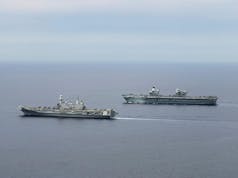Philip Dunne has responded to claims that there could be up to 800 redundancies from Clyde shipyards.
According to reports in the media, union representatives were told by BAE Systems that a “worst-case scenario” of 800 redundancies was possible if the UK government pulled back from its commitment to the manufacture of eight Type 26 frigates and “at least” five Type 31 frigates on the Clyde.
The defence minister has said the UK government remains “absolutely committed” to building eight Royal Navy frigates on the Clyde. Philip Dunne told the House of Commons “nothing had changed” since the plans were announced last November in a defence spending review.
Mr Dunne said the UK government’s commitment to Scotland and the Royal Navy was “crystal clear”:
“Let me assure the shipyard workers on the Clyde, this government remains absolutely committed to the Type-26 programme and to assembling the ships on the Clyde.”
Mr Dunne also promised the successor programme to the build would sustain 6,800 military and civilian jobs in Scotland, rising to 8,200 by 2022.
A MoD spokesperson said:
“The Government is committed to building ships on the Clyde and to the Type 26 programme. Over the next decade, we will spend around £8 billion on Royal Navy warships. As set out in the Strategic Defence and Security Review, we will build two new Offshore Patrol Vessels on the Clyde, maintaining Scottish shipbuilding capability ahead of the start of the Type 26 build. We will also consult with Industry and Trade Unions as part of the National Shipbuilding Strategy, which will set the UK shipbuilding industry on a sustainable footing for the future.”
Ahead of the announcement, the SNP and others had said that any reduction in the number of Type 26 frigates being built on the Clyde would be a “betrayal” of the workforce, with some MP’s even going so far as to claim “promises were broken”. A significant amount of MP’s from the Conservative party also posted strange and now deleted tweets regarding the number of frigates to be ordered.
The original plan for the class had been 8 anti-submarine warfare variants and five general purpose variants, this remains largely unchanged except for the specification of the later five vessels, which has been reduced to make them more affordable.
David Cameron told the House of Commons at the time:
“There will be eight of the Type 26s and at least another five of the new type of frigate, probably more, and they can be built in Scotland if the conditions are right. The only way these ships wouldn’t be built in Scotland is if Scotland was independent and didn’t have the national resources of the Royal Navy.”
Mr Cameron also told the Commons that the new class of frigates, now referred to as the Type 31, would be “more affordable than the Type 26 which will ” allow us to buy more of them for the Royal Navy so that by the 2030s we can further increase the total number of Royal Navy frigates and destroyers.”
Scottish Secretary David Mundell was asked whether he could guarantee that no jobs would be lost at the yards. He told BBC Scotland:
“We want to work with BAE Systems to ensure that they can put in place transitional arrangements that don’t mean that there are job losses. I think the announcement of the offshore patrol vessels was a clear demonstration of the government’s commitment to retain work on the Clyde.”
The Type 26 frigate represents the future backbone of the Royal Navy and a massive leap forward in terms of flexibility of surface vessels enjoyed by the service. It and the new Type 31 will replace the 13 Type 23 frigates of the Royal Navy and export orders are being sought after by BAE. The programme has been underway since 1998, initially under the name “Future Surface Combatant”. The programme was brought forward in the 2008 budget at the expense of Type 45 destroyers 7 and 8.
The Type 26 and Type 31 frigates, regardless of variant, will be adaptable and flexible frigates with a wide array of cutting edge sensors and weapons designed to help them effectively and efficiently meet evolving mission requirements. What’s more, they will all be built in Glasgow.













Colm Lock
Me thinks Save the royal navy are scare mongering because their journal isn’t going to do so well. With the navy becoming more and more capable.
They’re a very trusted and reliable source IMO.
Well that’s good. Tfti.
Just glad we’re building them.
I won’t completely believe it (that we’re building them) until I see first steel cut. That day will be such a relief to know that the delay after delay after delay is over. Maybe we will also get some final detail on design. The other thing I won’t believe until I see it is 24 Mk41 VLS. The rumoured spec on that one has switched between 16 and 24 so many times. It seems to now be widely reported at 24 but I would really like to see some more solid confirmation on that number before I believe it.
Good to hear. Hopefully we will see at least 2 or 3 more Type 31’s planned and ordered before the 2030’s. The UK government seems to be doing similar to what France is doing for it’s navy, a dozen or so larger “frigates and destroyers” vessels, followed by some light frigates.
Hopefully BAE will learn from the propulsion problems with the type 45…lets keep it simple so we can build a few more ships and stop throwing good money down the plug hole…
Can Jimmy Cranky shut her mouth now…
Just get on with it and start building!
Good Evening,
I do hope the UK Government builds these vessels as quickly as possible!
We require these Frigates sooner rather than later, taking into account the RN commitments and Putins increasing aggression!
It is about time the highly paid Defence Contractors took responsibility for the products they fit into warships and not expecting the client to pay for everything.
It should also be realised that as the Single Source Supplier (BAE), who have been granted exclusivity to naval contracts, should be out there bidding for, and getting, other work to ensure that their workforce do not have to rely on waxing and waning contracts
The Single Source Agreement is what gave us the 2nd carrier when we didn’t want it, it should be realised that the 2-3000 men employed in shipbuilding are paid for out of the Defence Budget.